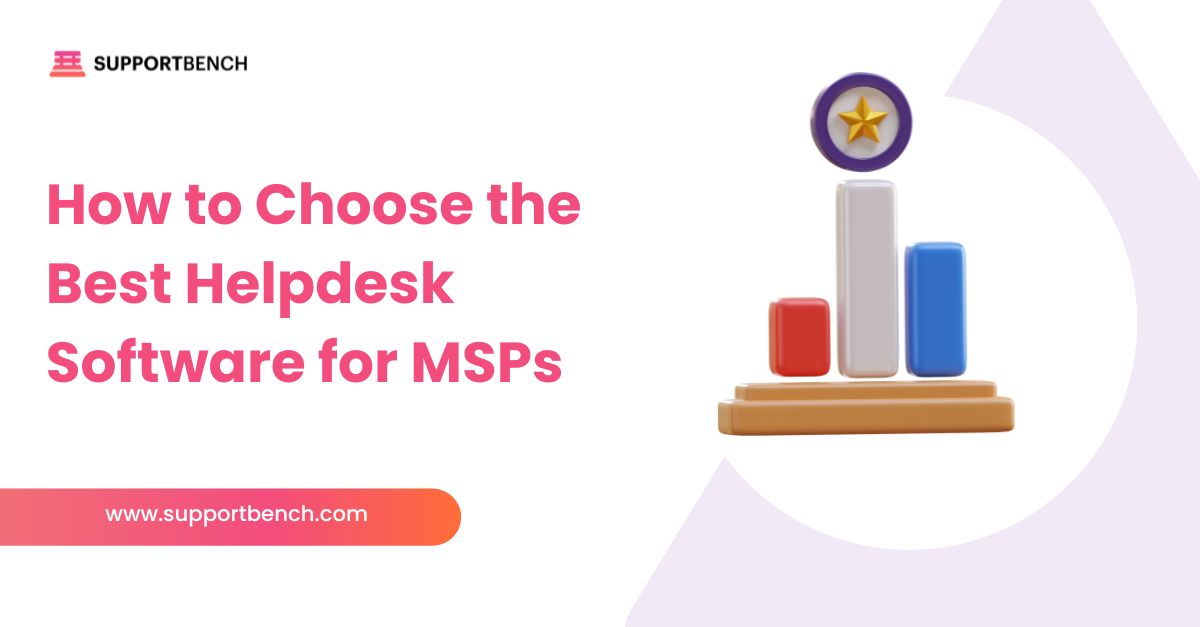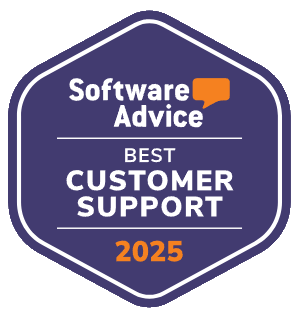Managed Service Providers (MSPs) and internal helpdesks play a critical role in ensuring fast, reliable support—but behind the scenes, they often struggle with similar issues: overworked teams, disconnected tools, inefficient workflows, and rising security risks.
These problems don’t just slow things down—they hurt service quality, employee morale, and customer satisfaction.
This guide breaks down the most common support pain points and offers practical, research-backed strategies for addressing them—while showing how Supportbench can help turn things around.

Here is the Quick Answer:
MSPs and internal helpdesks often face the same core challenges: staffing shortages, inefficient tools, reactive workflows, and burnout. These issues hurt both performance and morale. Solutions include hiring for focused roles, automating routine tasks, consolidating platforms, and improving internal and client communication. A data-driven, proactive approach is key to long-term efficiency. Supportbench provides a unified platform to streamline operations and address these common obstacles head-on.
Talent Shortages and Skill Constraints
Support teams—whether MSPs or internal helpdesks—are under pressure. The demand for skilled technicians outpaces supply, while unclear roles and generalized expectations slow down onboarding and reduce service quality.
MSPs: Short on Time and Talent
A 2020 Global MSP Benchmark Survey found out that over half of MSPs reported struggling to complete tasks on time or hire the right technical staff.1 These challenges haven’t gone away. To stay competitive, MSPs need to define specific expertise areas (like cybersecurity or M365) to streamline hiring and reduce training costs.
Internal Helpdesks: Burnout Is Real
In-house IT teams are juggling high ticket volumes, limited resources, and after-hours demands. Understaffing leads to missed SLAs and agent fatigue—two red flags that quality is slipping.
Actionable Fixes:
✔ Define clear advancement paths to improve retention.
✔ Narrow job scopes to match business needs instead of overloading roles with every tool.
✔ Promote focused certifications over generalist expectations.
✅ How Supportbench Helps: Supportbench lets teams streamline workflows, define roles with precision, and reduce complexity—allowing junior staff to work confidently and senior agents to focus on high-value tasks.
Inefficient Processes and Tool Overload
Disjointed tools and manual workflows drag support teams down. When platforms don’t talk to each other, agents waste time toggling between systems, repeating tasks, or hunting for context. This slows down response times and creates inconsistency across the customer experience.
Siloed Tools, Siloed Teams
Many MSPs and internal helpdesks juggle separate platforms for ticketing, remote monitoring, asset management, chat, and reporting. Without a centralized view, critical information gets lost—or worse, duplicated across channels.
Low-Value Tasks That Drain Resources
Basic but time-consuming tasks like password resets, new user setups, and VPN troubleshooting take up valuable agent hours. These recurring tickets pile up and prevent teams from focusing on more complex, strategic work.
Actionable Fixes:
✔ Consolidate platforms into one integrated helpdesk with remote monitoring and reporting.
✔ Automate routine workflows using self-service portals and escalation triggers.
✔ Assign queue managers to triage and redirect low-impact tickets before they clog up the pipeline.
✅ How Supportbench Helps: Supportbench’s no-code automation, integrated RMM, and smart ticket routing eliminate redundant steps and keep teams focused on what matters most—solving complex issues, not repeating simple tasks.

Reactive Posture and Poor Planning
When teams are constantly putting out fires, there’s no time—or energy—for proactive improvements. This short-term mindset creates unstable support environments and frustrated clients.
Always Reacting, Rarely Preventing
Many MSPs and internal helpdesks fall into a cycle of fixing issues only after they break. Whether it’s late patch deployment, neglected maintenance, or overdue updates, this reactive posture results in increased downtime and unresolved root causes.
Stagnant Ticket Queues
Without structured planning, ticket backlogs become the norm. A lack of triage discipline means urgent requests wait too long while repetitive tasks clutter the pipeline. Even early-release policies—intended as perks—can backfire if they delay accountability.
Actionable Fixes:
✔ Set up automated alerts and routine patch schedules to prevent common outages.
✔ Use daily ticket reviews to reprioritize workloads and enforce SLAs.
✔ Shift team culture with training focused on preventive support, not just fast resolution.
✅ How Supportbench Helps: Supportbench supports both reactive and proactive workflows with automated ticket escalation, SLA dashboards, and custom reporting. It gives managers full visibility and teams a roadmap for staying ahead of problems.
Communication Breakdowns
When teams fail to communicate clearly, both internal workflows and client relationships suffer. Without defined expectations and ownership, even small issues can escalate.
Inconsistent Client Updates
Clients expect transparency, especially during outages or delays. But without structured communication protocols, MSPs may miss status updates, delay incident alerts, or leave customers guessing. This erodes trust and makes service feel unreliable.

Poor Internal Collaboration
Disconnected departments—such as support and IT ops—can duplicate work, miss handoffs, or lose visibility into ticket progress. When no one owns the next step, nothing moves forward. Remote work only heightens the risk.
Actionable Fixes:
✔ Establish daily or weekly syncs to align across teams and flag blocked items.
✔ Use ticketing automation to prompt timely updates before SLA breaches.
✔ Assign clear ownership for each ticket and escalate if action stalls.
✅ How Supportbench Helps: Supportbench simplifies communication with internal tagging, automated update reminders, and shared ticket visibility across teams. It keeps everyone aligned and clients informed without extra overhead.
Scaling and Tool Integration Issues
As teams grow, processes often lag behind—creating inefficiencies and complexity that harm service delivery.
Growth Without Structure
MSPs taking on more clients—or internal helpdesks supporting expanding departments—often scale headcount and tools without rethinking workflows. This leads to chaotic ticket queues, inconsistent quality, and staff burnout.
Tool Sprawl and Fragmentation
Adding tools reactively—each for a single use case—can result in disconnected platforms for scheduling, chat, reporting, and monitoring. Switching between them wastes time and creates data silos.
Actionable Fixes:
✔ Build scalable workflows tied to ticket volumes and headcount growth.
✔ Consolidate tools into a centralized PSA or helpdesk platform with built-in integrations.
✔ Audit your tech stack every quarter to eliminate unused or overlapping solutions.
✅ How Supportbench Helps: Supportbench integrates core functions—ticketing, scheduling, RMM, and reporting—within a single platform. It reduces the need for tool-switching and supports long-term scalability with ease.

Security and Compliance Vulnerabilities
When internal controls are weak or patching is delayed, both MSPs and in-house helpdesks become high-risk entry points.
Third-Party Risk Is Still Your Risk
A significant share of data breaches involve external vendors. Yet many businesses outsource support functions without fully vetting providers’ internal security standards. Without clear accountability, vulnerabilities multiply.
Delays Create Exposure
Helpdesks often miss critical security updates due to unclear patching responsibilities or misaligned priorities. This leaves systems open to ransomware, phishing, or data loss—especially when endpoints and servers aren’t centrally monitored.
Actionable Fixes:
✔ Implement security protocols for helpdesk teams (multi-factor authentication, endpoint monitoring, access logs).
✔ Define patching SLAs and assign ownership of security updates.
✔ Schedule regular third-party reviews and internal audits to enforce compliance.
✅ How Supportbench Helps: Supportbench supports internal security best practices with granular access controls, audit-ready data trails, and SLA-driven workflows that prioritize critical updates.
Managing Client and Internal Expectations
Even technically sound support operations can lose trust if they overpromise, miscommunicate, or set unclear expectations.
Broken Promises, Broken Trust
Many MSPs market 24/7 automation and seamless efficiency—but fail to meet those claims in practice. Features may be oversold or poorly delivered. Similarly, internal teams often suffer when leadership offers token perks (like early leave days) while ignoring systemic issues, leading to disillusionment and burnout.
Communication Isn’t a One-Off
Clients expect more than ticket resolutions—they want visibility. Missed updates, vague timelines, or unclear escalation processes frustrate users and erode satisfaction. Internally, a lack of shared context between departments often leads to finger-pointing or duplicated work.
Actionable Fixes:
✔ Align messaging with real capabilities. Set realistic SLAs, share what’s included (and what’s not), and communicate scope changes clearly.
✔ Create structured reporting for clients—track CSAT, uptime, resolution time—and share progress on agreed intervals.
✔ Internally, tie service quality to performance metrics and recognize ownership. Make ticket accountability part of how success is measured.
✅ How Supportbench Helps: Supportbench lets you customize dashboards, set SLA expectations, and automate notifications for clients and teams. Built-in reporting tools help teams quantify value and demonstrate service quality across every touchpoint.

Burnout and Tokenism
Short-term perks can’t fix long-term fatigue. Without real structural changes, support teams face morale drops and unsustainable workloads.
When Workloads Wear Teams Down
Agents juggling repetitive tickets, night coverage, and unresolved backlogs eventually hit a breaking point. Signs of burnout—slower response times, irritability, and absenteeism—often emerge before managers notice.
When Perks Miss the Point
Throwing in casual rewards like early release or pizza Fridays may temporarily lift spirits, but they don’t resolve underlying stressors. If expectations remain unrealistic, token efforts backfire, fueling resentment.
Actionable Fixes:
✔ Rotate team duties to introduce variety: shift agents between frontline support, audits, and account reviews.
✔ Monitor for signs of fatigue with real metrics—such as rising ticket handle times or missed SLAs.
✔ Implement performance frameworks tied to sustainable goals and regular feedback—not isolated incentives.
✅ How Supportbench Helps: Supportbench provides visibility into team workloads and SLA performance. Its customizable dashboards help managers spot burnout early and rebalance assignments. Role-based workflows also make it easier to rotate responsibilities and give agents a break from repetitive tasks.
Financial Sustainability and Profitability
Growing revenue doesn’t guarantee higher margins—especially when inefficiencies are left unchecked. Profitability depends on structure, not just scale.
Hidden Costs Drain Resources
Manual steps like scheduling, repeated escalations, or duplicate tickets quietly chip away at profitability. When senior staff handle basic issues, it inflates labour costs and delays higher-value work.
Margin Under Pressure
As MSPs and internal helpdesks move to subscription or recurring revenue models, inefficient processes and tool sprawl reduce returns. Without optimization, growth just multiplies the problem.
Actionable Fixes:
✔ Automate common tasks: ticket triage, escalation, reporting, and scheduling.
✔ Use clear, predictable billing models—per-user, per-device, or tiered—to stabilize income.
✔ Analyze operational costs by ticket category to refine pricing and staffing strategies.
✅ How Supportbench Helps: Supportbench enables workflow automation without code, reducing manual intervention across tasks. Integrated cost-tracking and ticket-type analytics give you the data needed to optimize operations and preserve profitability.

Measuring and Demonstrating Success
You can’t improve what you don’t measure—and you can’t prove your value without data.
Operating Blind Without Metrics
Many support teams operate on gut feeling. Without structured metrics, it’s impossible to identify what’s working, what’s failing, or where to invest. This leads to missed opportunities for performance gains and weak justification for client spend.
Evidence Builds Trust
Clients expect more than anecdotal updates—they want to see tangible outcomes. Metrics like uptime, resolution speed, and SLA compliance are essential for showing impact. Internally, these same numbers help optimize resources and improve morale.
Actionable Fixes:
✔ Track performance KPIs: SLA compliance, first-contact resolution, CSAT, average handle time.
✔ Share real-time dashboards with internal teams and clients on a regular basis.
✔ Use data insights to guide staffing, tool investments, and process refinements.
✅ How Supportbench Helps: Supportbench offers customizable dashboards, real-time analytics, and automated reporting. These tools allow teams to track results continuously, demonstrate value to stakeholders, and make confident decisions backed by data.
Where Supportbench Fits in Your Helpdesk Strategy
Supportbench isn’t just another helpdesk tool—it’s a response to real, persistent problems that MSPs and internal helpdesks face every day.
Our platform combines automation, integrated workflows, and real-time data visibility to streamline daily operations. Agents benefit from intuitive dashboards and smart suggestions, while managers get performance tracking and customizable workflow control—without needing to write code.
With features like no-code escalation paths, self-service options, and AI-powered triage, Supportbench directly addresses time waste, tool bloat, and reporting gaps. Migration is straightforward, and support is always on hand to guide the transition.
That said, every helpdesk team has its own needs. The right tool is the one that fits your operational challenges—not the one with the longest feature list.
✅ Why Supportbench? Because your support system should reduce burnout, not cause it. Should scale with your business, not against it. And should empower agents, not overwhelm them. Supportbench helps you get there—with clarity, speed, and measurable value.
Conclusion
MSPs and internal helpdesks face a familiar mix of challenges—talent shortages, disconnected tools, reactive support, weak communication, burnout, and growing compliance pressure. Left unchecked, these problems weaken service quality and stall long-term growth.
The solution isn’t one-size-fits-all. It starts with building specialized teams, reducing tool clutter, and automating low-value tasks to focus staff time where it matters. Structured workflows and consistent communication help reduce confusion and raise accountability.
Security must be embedded into operations—not treated as an afterthought. From patching delays to vendor oversight, proactive protection is essential.
Financial sustainability also depends on accuracy. Align pricing models with real delivery costs and use data—not guesswork—to track performance.
Supportbench helps teams tackle these issues with a unified platform that blends ticketing, AI, automation, and reporting. It’s built for modern support operations that need to scale without chaos.
See how Supportbench can transform your support workflow. Book a free demo today.















